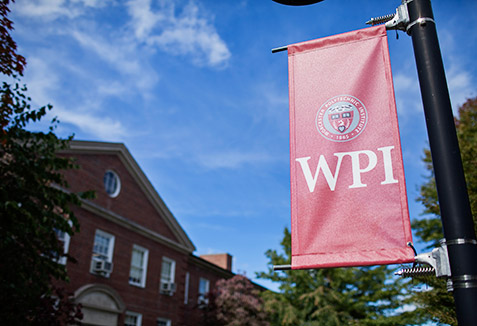The Center for Inorganic Membrane Studies at Worcester Polytechnic Institute (WPI) has received a $1.5 million, 15-month award from the U.S. Department of Energy to advance patented technology using palladium membranes that can separate hydrogen from various gases. The project will seek to demonstrate that the membranes can lower the cost of generating electricity with advanced coal gasification systems while also reducing greenhouse gas emissions by isolating the carbon dioxide produced by coal gas combustion.
WPI's research team is one of four nationwide to receive a total of $5.9 million for demonstration projects involving membranes made from the precious metal palladium. The other groups are led by Praxair Inc., United Technologies Research Center, and Western Research Institute. WPI, the only university to receive an award, will lead the research in collaboration with Membrane Technology and Research in Menlo Park, Calif., Siemens Energy America in Orlando, Fla., and T3 Scientific in Blaine, Minn. WPI's technology will be tested at the Power Systems Development Facility/National Carbon Capture Center in Wilsonville, Ala.
In this initial phase of the project, the four research teams will develop and pilot test membrane systems using simulated coal gas; the goal will be to produce two pounds of hydrogen per day from the gas. Two teams will be selected to continue on to the project's second and third phases, which will involve building a larger membrane module that can produce 100 pounds of hydrogen a day, and then installing and testing that module in a demonstration plant. Should the WPI research team, which is led by Yi Hua "Ed" Ma, James B. Manning Professor of Chemical Engineering and director of the WPI Center for Inorganic Membrane Studies, succeed in this pilot phase, it could receive a total of $8.5 million in DOE funding over the life of the project.
"I commend Professor Ma and his collaborators on winning this prestigious and important award," said WPI President Dennis Berkey. "By demonstrating the effectiveness of Professor Ma's innovative membrane technology to produce electricity, hydrogen, and synthesis gas, and ultimately bringing this technology to industrial scale, this project can result in new, cost-effective sources of clean energy."
WPI's Center for Inorganic Membrane Studies was a pioneer in the development of ultrathin palladium membranes for use in separating hydrogen from natural gas, coal gas, and renewable fuels. A palladium membrane permits only hydrogen to pass through, allowing it to be separated from the carbon dioxide and other compounds in the gas stream. The work at WPI has been funded by major awards from the Department of Energy, Shell International Exploration & Production, and Shell Hydrogen. Shell has used the university's technology in a reactor that may become the heart of a hydrogen refueling network for cars powered by fuel cells.
One of the WPI research team's key innovations was developing ways to build the membranes on porous metal supports, rather than the more common ceramic supports. Metal supports enable the palladium membranes to be thinner, and thus less expensive to manufacture, and also make them easier to integrate into reactors and other process equipment. The team solved a critical problem by developing a method for building up a protective oxide layer on top of the metal support, then forming the palladium membrane over that. The process keeps the metal from contaminating the palladium at high temperatures. The WPI team has received six patents for its work to date.
In the current project, the WPI team will demonstrate how its membrane technology could be incorporated into an integrated gasification combined cycle (IGCC) electric power plant, which combines processes for gasifying coal and burning the coal gas to generate electricity. IGCC plants have proven to be expensive to construct and operate. The DOE is hoping that the addition of membrane systems could make them more cost-effective by producing hydrogen that can either be burned as an additional fuel in the power plant or sold as a fuel or chemical feedstock. The process of hydrogen separation has the added benefit of making it easier to isolate and remove carbon dioxide, a greenhouse gas, from coal gas, which would make IGCC plants less polluting.
In addition to scaling up the WPI membrane technology to meet the goal of producing two pounds of hydrogen a day, Ma says his team will face an important challenge in building a system that can work as part of an IGCC: preventing sulfur in the coal gas from contaminating the palladium and reducing the membrane's permeability. Toward that end, they will test a sulfur-resistant coating made by T3, a company founded by a former member of Ma's research team, Chung-Yi Andy Tsai '96 (PhD, chemical engineering).
"As the nation works to develop effective alternatives to fossil fuels, coal--which is now the source for half of all of our electricity--will remain an important fuel," notes Ma. "This research could be an important step toward creating new technology that allows us to produce even more power from coal, but to do so in a way that is not harmful to the environment. I am pleased that the work we have done here at WPI on palladium membranes over the course of more than a decade could play an important role in this solution."
About Worcester Polytechnic Institute
Founded in 1865 in Worcester, Mass., WPI was one of the nation's first engineering and technology universities. Its14 academic departments offer more than 50 undergraduate and graduate degree programs in science, engineering, technology, management, the social sciences, and the humanities and arts, leading to bachelor’s, master’s and PhD degrees. WPI's world-class faculty work with students in a number of cutting-edge research areas, leading to breakthroughs and innovations in such fields as biotechnology, fuel cells, information security, materials processing, and nanotechnology. Students also have the opportunity to make a difference to communities and organizations around the world through the university's innovative Global Projects Program. There are more than 25 WPI project centers throughout North America and Central America, Africa, Australia, Asia, and Europe.

